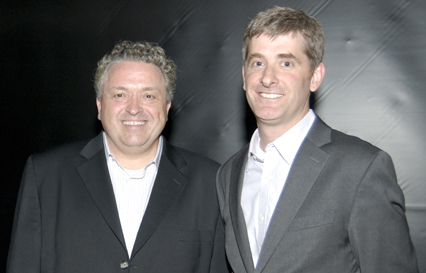GRAPHIC DESIGN LEGEND BRUCE MAU SPEAKS AT PRATT
Mau Urges Optimism and Design-Thinking for Solving World's Problems
 L-R: Bruce Mau, Jeff Bellantoni, chair of the Department of Communications/Package Design Mau spoke to a packed Memorial Hall on November 4 as part of the Department of Communications Design’s lecture series.
L-R: Bruce Mau, Jeff Bellantoni, chair of the Department of Communications/Package Design Mau spoke to a packed Memorial Hall on November 4 as part of the Department of Communications Design’s lecture series.
The Canadian-born designer described the sweeping changes he has seen in both his life—he grew up in a mining town where his home did not have running water during the coldest months—and in the design field.
When he first launched his firm Public Good 27 years ago, he recalls, “people were still using hot metal type,” and the notion of designers using their skills to do more than sell products, was almost unheard of.
“I was surprised at how much anger it generated,” he recalled. “Designers were angry. They were not doing that, and they knew it.”
Yet, he said, designers inherently want to do good.
“We are committed to improving and developing the world. That’s why there are so many of us.”
Mau showed examples of some of his major projects, including his work with Guatemala to change its citizens’ perception of their country; his collaboration with architect Frank Gehry on the design of the Panama Museum of Biodiversity; his design of a visual identity for the new Museum of Modern Art; and his work on a 20-year-plan for the city of Mecca.
Common to these projects was a notion that Mau says is integral to design these days: “Design the system, not the object.”
Mau was one of the first designers to bring this concept to the design field, beginning a collaboration in the late 1980s with Zone Books, one of the first publishers to use design not just to illustrate written content, but as the content itself.
“It introduced me to a world of authorship, a form and content marriage, that was about being an author in both of those realms.”
Most recently, Mau has focused on education and designing education systems that have a global impact.
“The world we are experiencing was created by educating less than one percent of the world,” he said. “Imagine if we doubled that.”
In 2003, Mau co-founded the Institute Without Boundaries to consider how design thinking can be applied to solving the world’s largest problems such as crumbling infrastructure and the global housing shortage.
The question now, he said, is “Can we ‘massive change’ education? Imagine a global network of entrepreneurial design learning studios. If we could connect them to 100,000 designers committed to action, half of them might start new businesses.”
Mau ended his presentation with 10 lessons in line with his famous “Incomplete Manifesto,” a list of inspirational guidelines for being a successful designer.
Among his final words of advice to the students was: “Worst equals best. The more challenging a situation is, the better it is for a designer.”
Photo: Diana Pau
 Gateway Editors |
Gateway Editors |  Post a Comment |
Post a Comment |  Print Article
Print Article  Email Article
Email Article  Wednesday, November 3, 2010 at 01:10PM
Wednesday, November 3, 2010 at 01:10PM  4 References |
4 References | 
Reader Comments